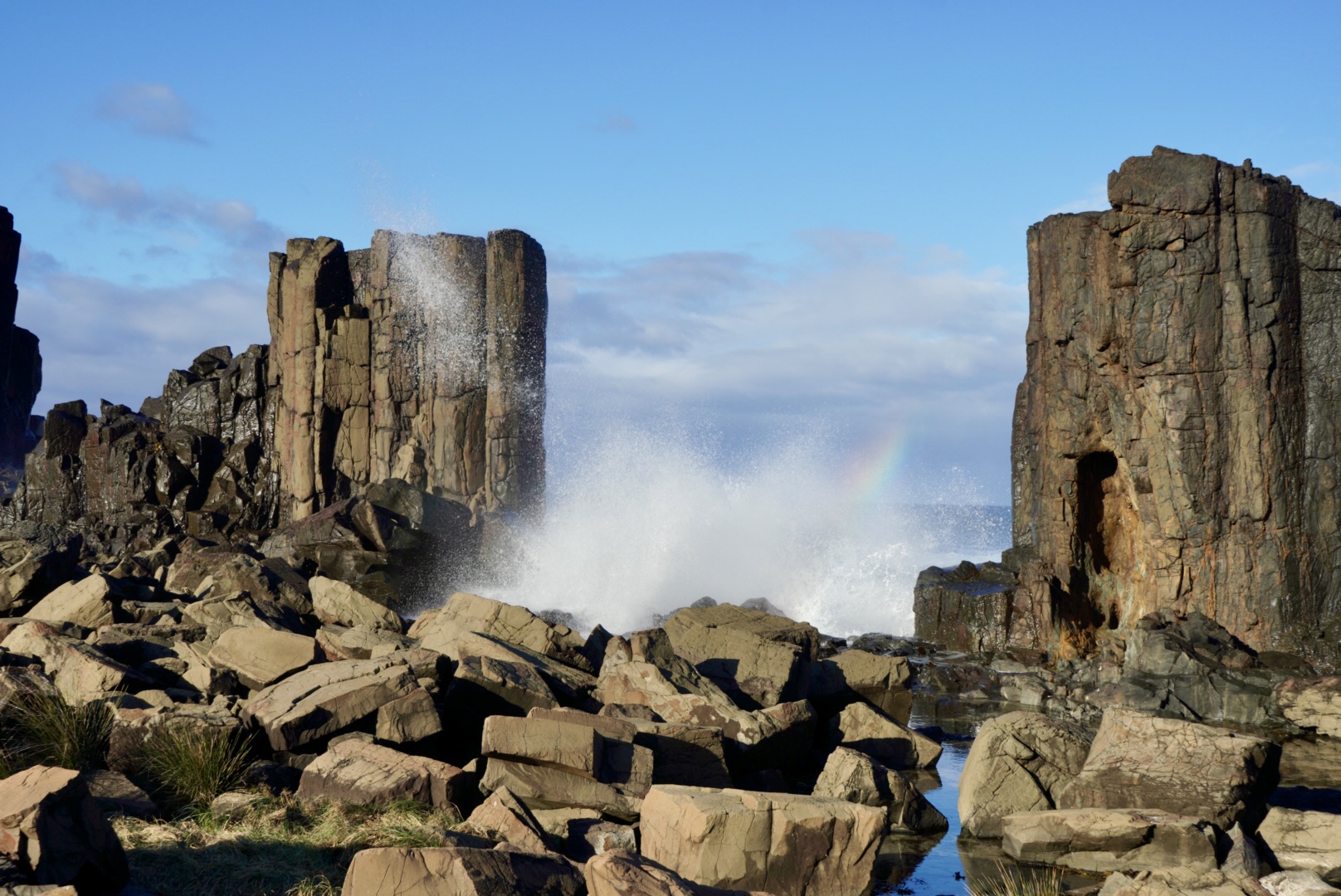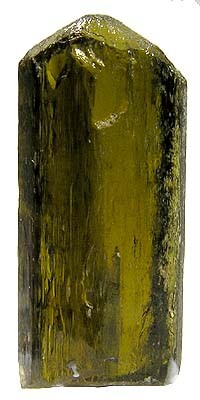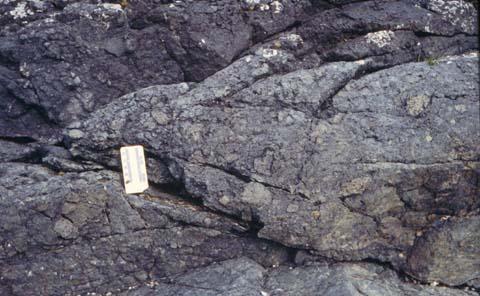|
Bombo Headland Quarry Geological Site
Bombo Headland Quarry Geological Site is a heritage-listed former quarry and now geological site at Princes Highway, Bombo, Municipality of Kiama, New South Wales, Australia. It is also known as Bombo Quarry. It was added to the New South Wales State Heritage Register on 2 April 1999. History In 1979 a nomination was received from the Geological Society of Australia (NSW Division) for the Bombo Quarry. The importance of the geological features was brought to the Heritage Council's attention by Dr. Suzanne Wass of Macquarie University's School of Earth Sciences. The quarry was owned by the Metropolitan Water, Sewerage, and Drainage Board and it was proposed that a pollution control plant be constructed on the floor of the disused quarry. It also made an appearance in '' Mighty Morphin Power Rangers: The Movie'' as part of the planet Phaedos. Following site inspections and lengthy consultations between the Metropolitan Water, Sewerage and Drainage Board, NSW Heritage Council ... [...More Info...] [...Related Items...] OR: [Wikipedia] [Google] [Baidu] |
Bombo, New South Wales
Bombo is a suburb of the Municipality of Kiama, in the Illawarra region of New South Wales, Australia. It is located north of Kiama. Etymology Bombo is derived from "Thumbon", the name of a renowned headman and warrior born in this district. Infrastructure Bombo is the gateway between Kiama and its northern suburbs, Kiama Downs and Minnamurra. The Princes Highway runs through Bombo. In November 2005 a new six lane road opened replacing the original two lane road. Bombo railway station opened in 1887 as the terminus of the Illawarra railway line. In 1893 the line was extended to Kiama. It is the closest railway station to the Pacific Ocean in New South Wales. In the 1950s the New South Wales Government Railways established a ballast quarry. Boral operated an adjoining quarry from the 1970s until 2014. The Bombo disaster The basalt quarry at Bombo was the site of a serious accident on 7 May 1888, when an explosive charge detonated prematurely and a mass of rock fell to the g ... [...More Info...] [...Related Items...] OR: [Wikipedia] [Google] [Baidu] |
Feldspar
Feldspars are a group of rock-forming aluminium tectosilicate minerals, also containing other cations such as sodium, calcium, potassium, or barium. The most common members of the feldspar group are the ''plagioclase'' (sodium-calcium) feldspars and the ''alkali'' (potassium-sodium) feldspars. Feldspars make up about 60% of the Earth's crust, and 41% of the Earth's continental crust by weight. Feldspars crystalize from magma as both intrusive and extrusive igneous rocks and are also present in many types of metamorphic rock. Rock formed almost entirely of calcic plagioclase feldspar is known as anorthosite. Feldspars are also found in many types of sedimentary rocks. Compositions The feldspar group of minerals consists of tectosilicates, silicate minerals in which silicon ions are linked by shared oxygen ions to form a three-dimensional network. Compositions of major elements in common feldspars can be expressed in terms of three endmembers: * potassium feldspar (K-spar) ... [...More Info...] [...Related Items...] OR: [Wikipedia] [Google] [Baidu] |
Apatite
Apatite is a group of phosphate minerals, usually hydroxyapatite, fluorapatite and chlorapatite, with high concentrations of OH−, F− and Cl− ions, respectively, in the crystal. The formula of the admixture of the three most common endmembers is written as Ca10( PO4)6(OH,F,Cl)2, and the crystal unit cell formulae of the individual minerals are written as Ca10(PO4)6(OH)2, Ca10(PO4)6F2 and Ca10(PO4)6Cl2. The mineral was named apatite by the German geologist Abraham Gottlob Werner in 1786, although the specific mineral he had described was reclassified as fluorapatite in 1860 by the German mineralogist Karl Friedrich August Rammelsberg. Apatite is often mistaken for other minerals. This tendency is reflected in the mineral's name, which is derived from the Greek word ἀπατάω (apatáō), which means ''to deceive''. Geology Apatite is very common as an accessory mineral in igneous and metamorphic rocks, where it is the most common phosphate mineral. However, occu ... [...More Info...] [...Related Items...] OR: [Wikipedia] [Google] [Baidu] |
Hornblendite
Hornblendite is a plutonic rock consisting mainly of the amphibole hornblende. Hornblende-rich ultramafic rocks are rare and when hornblende is the dominant mineral phase they are classified as hornblendites with qualifiers such as garnet hornblendite identifying a second abundant contained mineral. Metamorphic rock Metamorphic rocks arise from the transformation of existing rock to new types of rock in a process called metamorphism. The original rock (protolith) is subjected to temperatures greater than and, often, elevated pressure of or more, causin ...s composed dominantly of amphiboles are referred to as amphibolites. References * Blatt, Harvey and Robert J. Tracy (1996) ''Petrology'', Freeman, p. 72, {{petrology-stub Igneous petrology Plutonic rocks ... [...More Info...] [...Related Items...] OR: [Wikipedia] [Google] [Baidu] |
Pyroxenite
Pyroxenite is an ultramafic igneous rock consisting essentially of minerals of the pyroxene group, such as augite, diopside, hypersthene, bronzite or enstatite. Pyroxenites are classified into clinopyroxenites, orthopyroxenites, and the websterites which contain both types of pyroxenes (see diagram below). Closely allied to this group are the hornblendites, consisting essentially of hornblende and other amphiboles. They are essentially of igneous origin, though some pyroxenites are included in the metamorphic Lewisian complex of Scotland. The pyroxene-rich rocks, which result from the type of contact metamorphism known as pyroxene-hornfels facies, have siliceous sediment or basaltic protoliths, and are respectively metapelites and metabasites. Intrusive and mantle pyroxenites Igneous pyroxenites are closely allied to gabbros and norites, from which they differ by the absence of feldspar, and to peridotites, which are distinguished from them by containing more than 40% olivine. ... [...More Info...] [...Related Items...] OR: [Wikipedia] [Google] [Baidu] |
Enstatite
Enstatite is a mineral; the magnesium endmember of the pyroxene silicate mineral series enstatite (MgSiO3) – ferrosilite (FeSiO3). The magnesium rich members of the solid solution series are common rock-forming minerals found in igneous and metamorphic rocks. The intermediate composition, , has historically been known as hypersthene, although this name has been formally abandoned and replaced by orthopyroxene. When determined petrographically or chemically the composition is given as relative proportions of enstatite (En) and ferrosilite (Fs) (e.g., En80Fs20). Polymorphs and varieties Most natural crystals are orthorhombic (space group P''bca'') although three polymorphs are known. The high temperature, low pressure polymorphs are protoenstatite and protoferrosilite (also orthorhombic, space group P''bcn'') while the low temperature forms, clinoenstatite and clinoferrosilite, are monoclinic (space group P2''1/c''). Weathered enstatite with a small amount of iron takes on ... [...More Info...] [...Related Items...] OR: [Wikipedia] [Google] [Baidu] |
Peridotite
Peridotite ( ) is a dense, coarse-grained igneous rock consisting mostly of the silicate minerals olivine and pyroxene. Peridotite is ultramafic, as the rock contains less than 45% silica. It is high in magnesium (Mg2+), reflecting the high proportions of magnesium-rich olivine, with appreciable iron. Peridotite is derived from Earth's mantle, either as solid blocks and fragments, or as crystals accumulated from magmas that formed in the mantle. The compositions of peridotites from these layered igneous complexes vary widely, reflecting the relative proportions of pyroxenes, chromite, plagioclase, and amphibole. Peridotite is the dominant rock of the upper part of Earth's mantle. The compositions of peridotite nodules found in certain basalts are of special interest along with diamond pipes (kimberlite), because they provide samples of Earth's mantle brought up from depths ranging from about 30 km to 200 km or more. Some of the nodules preserve isotope ratios of osm ... [...More Info...] [...Related Items...] OR: [Wikipedia] [Google] [Baidu] |
Augite
Augite is a common rock-forming pyroxene mineral with formula . The crystals are monoclinic and prismatic. Augite has two prominent cleavages, meeting at angles near 90 degrees. Characteristics Augite is a solid solution in the pyroxene group. Diopside and hedenbergite are important endmembers in augite, but augite can also contain significant aluminium, titanium, and sodium and other elements. The calcium content of augite is limited by a miscibility gap between it and pigeonite and orthopyroxene: when occurring with either of these other pyroxenes, the calcium content of augite is a function of temperature and pressure, but mostly of temperature, and so can be useful in reconstructing temperature histories of rocks. With declining temperature, augite may exsolve lamellae of pigeonite and/or orthopyroxene. There is also a miscibility gap between augite and omphacite, but this gap occurs at higher temperatures. There are no industrial or economic uses for this mineral. Locatio ... [...More Info...] [...Related Items...] OR: [Wikipedia] [Google] [Baidu] |
Gabbro
Gabbro () is a phaneritic (coarse-grained), mafic intrusive igneous rock formed from the slow cooling of magnesium-rich and iron-rich magma into a holocrystalline mass deep beneath the Earth's surface. Slow-cooling, coarse-grained gabbro is chemically equivalent to rapid-cooling, fine-grained basalt. Much of the Earth's oceanic crust is made of gabbro, formed at mid-ocean ridges. Gabbro is also found as plutons associated with continental volcanism. Due to its variant nature, the term ''gabbro'' may be applied loosely to a wide range of intrusive rocks, many of which are merely "gabbroic". By rough analogy, gabbro is to basalt as granite is to rhyolite. Etymology The term "gabbro" was used in the 1760s to name a set of rock types that were found in the ophiolites of the Apennine Mountains in Italy. It was named after Gabbro, a hamlet near Rosignano Marittimo in Tuscany. Then, in 1809, the German geologist Christian Leopold von Buch used the term more restrictively in his descri ... [...More Info...] [...Related Items...] OR: [Wikipedia] [Google] [Baidu] |
Hypersthene
Hypersthene is a common rock-forming inosilicate mineral belonging to the group of orthorhombic pyroxenes. Its chemical formula is . It is found in igneous and some metamorphic rocks as well as in stony and iron meteorites. Many references have formally abandoned this term, preferring to categorise this mineral as enstatite or ferrosilite. It forms a solid solution series with the minerals enstatite and ferrosilite, being a mid-way member between the two. Pure enstatite contains no iron, while pure ferrosilite contains no magnesium; hypersthene is the name given to the mineral when a significant amount of both elements are present. Enstatite is stable at atmospheric pressure, but ferrosilite is stable only at elevated pressure, decomposing into quartz and fayalite at atmospheric pressure unless stabilized by magnesium or other impurities. Distinctly developed crystals are rare, the mineral being usually found as foliated masses embedded in the igneous rocks norite and hypersthen ... [...More Info...] [...Related Items...] OR: [Wikipedia] [Google] [Baidu] |
Magma
Magma () is the molten or semi-molten natural material from which all igneous rocks are formed. Magma is found beneath the surface of the Earth, and evidence of magmatism has also been discovered on other terrestrial planets and some natural satellites. Besides molten rock, magma may also contain suspended crystals and gas bubbles. Magma is produced by melting of the mantle or the crust in various tectonic settings, which on Earth include subduction zones, continental rift zones, mid-ocean ridges and hotspots. Mantle and crustal melts migrate upwards through the crust where they are thought to be stored in magma chambers or trans-crustal crystal-rich mush zones. During magma's storage in the crust, its composition may be modified by fractional crystallization, contamination with crustal melts, magma mixing, and degassing. Following its ascent through the crust, magma may feed a volcano and be extruded as lava, or it may solidify underground to form an intrusion, such as a ... [...More Info...] [...Related Items...] OR: [Wikipedia] [Google] [Baidu] |
Agglomerate
Agglomerate (from the Latin ''agglomerare'' meaning "to form into a ball") is a coarse accumulation of large blocks of volcanic material that contains at least 75% bombs. Volcanic bombs differ from volcanic blocks in that their shape records fluidal surfaces: they may, for example, have ropy, cauliform, scoriaceous, folded, spindle, spatter, ribbon, ragged, or amoeboid shapes. Globular masses of lava may have been shot from the crater at a time when partly molten lava was exposed, and was frequently shattered by sudden outbursts of steam. These bombs were viscous at the moment of ejection and by rotation in the air acquired their shape. They are commonly in diameter, but specimens as large as have been observed. There is less variety in their composition at any one volcanic centre than in the case of the lithic blocks, and their composition indicates the type of magma being erupted. Agglomerates are typically found near volcanic vents and within volcanic conduits, where they m ... [...More Info...] [...Related Items...] OR: [Wikipedia] [Google] [Baidu] |








